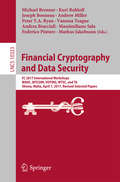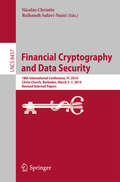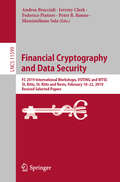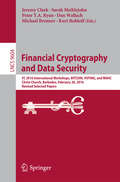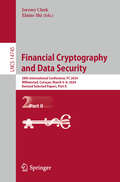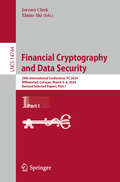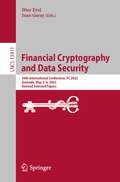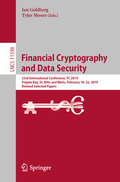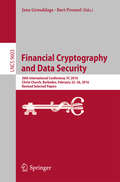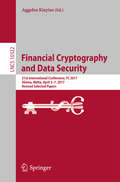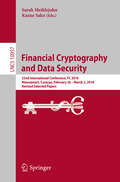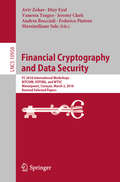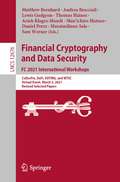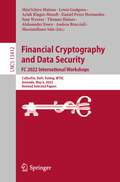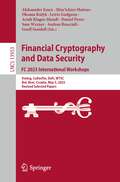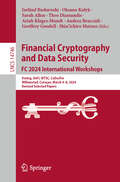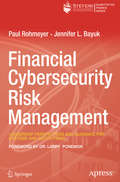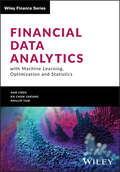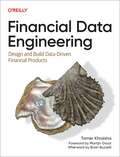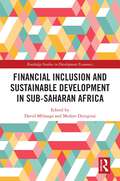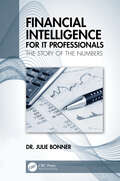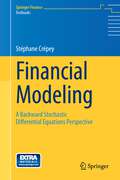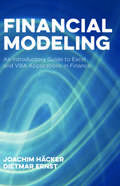- Table View
- List View
Financial Cryptography and Data Security
by Michael Brenner Andrew Miller Markus Jakobsson Joseph Bonneau Kurt Rohloff Vanessa Teague Peter Y.A. Ryan Andrea Bracciali Massimiliano Sala Federico PintoreThis book constitutes the thoroughly refereed post-conference proceedings of the workshop on Usable Security, USEC 2013, and the third Workshop on Applied Homomorphic Cryptography, WAHC 2013, held in conjunction with the 17th International Conference on Financial Cryptology and Data Security, FC 2013, in Okinawa, Japan. The 16 revised full papers presented were carefully selected from numerous submissions and cover all aspects of data security. The goal of the USEC workshop was to engage on all aspects of human factors and usability in the context of security. The goal of the WAHC workshop was to bring together professionals, researchers and practitioners in the area of computer security and applied cryptography with an interest in practical applications of homomorphic encryption, secure function evaluation, private information retrieval or searchable encryption to present, discuss, and share the latest findings in the field, and to exchange ideas that address real-world problems with practical solutions using homomorphic cryptography.
Financial Cryptography and Data Security
by Nicolas Christin Reihaneh Safavi-NainiThis book constitutes the thoroughly refereed post-conference proceedings of the 18th International Conference on Financial Cryptography and Data Security (FC 2014), held in Christ Church, Barbados, in March 2014. The 19 revised full papers and 12 short papers were carefully selected and reviewed from 165 abstract registrations and 138 full papers submissions. The papers are grouped in the following topical sections: payment systems, case studies, cloud and virtualization, elliptic curve cryptography, privacy-preserving systems, authentication and visual encryption, network security, mobile system security, incentives, game theory and risk, and bitcoin anonymity.
Financial Cryptography and Data Security: FC 2019 International Workshops, VOTING and WTSC, St. Kitts, St. Kitts and Nevis, February 18–22, 2019, Revised Selected Papers (Lecture Notes in Computer Science #11599)
by Jeremy Clark Andrea Bracciali Massimiliano Sala Federico Pintore Peter B. RønneThis book constitutes the refereed proceedings of two workshops held at the 23rd International Conference on Financial Cryptography and Data Security, FC 2019, in St. Kitts, St. Kitts and Nevis, in February 2019.The 20 full papers and 4 short papers presented in this book were carefully reviewed and selected from 34 submissions.The papers feature the outcome of the 4th Workshop on Advances in Secure Electronic Voting, VOTING 2019 and the Third Workshop on Trusted Smart Contracts, WTSC 2019. VOTING covered topics like election auditing, voting system efficiency, voting system usability, and new technical designs for cryptographic protocols for voting systems.WTSC focuses on smart contracts, i.e., self-enforcing agreements in the form of executable programs, and other decentralized applications that are deployed to and run on top of (specialized) blockchains.
Financial Cryptography and Data Security
by Jeremy Clark Sarah Meiklejohn Peter Y.A. Ryan Dan Wallach Michael Brenner Kurt RohloffThis book constitutes the thoroughly refereed post-conference proceedings of the workshop on Usable Security, USEC 2013, and the third Workshop on Applied Homomorphic Cryptography, WAHC 2013, held in conjunction with the 17th International Conference on Financial Cryptology and Data Security, FC 2013, in Okinawa, Japan. The 16 revised full papers presented were carefully selected from numerous submissions and cover all aspects of data security. The goal of the USEC workshop was to engage on all aspects of human factors and usability in the context of security. The goal of the WAHC workshop was to bring together professionals, researchers and practitioners in the area of computer security and applied cryptography with an interest in practical applications of homomorphic encryption, secure function evaluation, private information retrieval or searchable encryption to present, discuss, and share the latest findings in the field, and to exchange ideas that address real-world problems with practical solutions using homomorphic cryptography.
Financial Cryptography and Data Security: 28th International Conference, FC 2024, Willemstad, Curaçao, March 4–8, 2024, Revised Selected Papers, Part II (Lecture Notes in Computer Science #14745)
by Jeremy Clark Elaine ShiThe two-volume set LNCS 14744 + 14745 constitutes the proceedings of the 28th International Conference on Financial Cryptography and Data Security, FC 2024, which took place in Willemstad, Curaçao, during March 4–8, 2024. The number of 36 full and 6 short papers included in the proceedings were carefully reviewed and selected from 199 submissions. They were organized in topical sections as follows: Part I: Consensus; AMMs; fees and rewards; hardware attacks; Part II: Feeling Optimistic; randomness and time; signatures; applied cryptography; PETS; designing for the real world.
Financial Cryptography and Data Security: 28th International Conference, FC 2024, Willemstad, Curaçao, March 4–8, 2024, Revised Selected Papers, Part I (Lecture Notes in Computer Science #14744)
by Jeremy Clark Elaine ShiThe two-volume set LNCS 14744 + 14745 constitutes the proceedings of the 28th International Conference on Financial Cryptography and Data Security, FC 2024, which took place in Willemstad, Curaçao, during March 4–8, 2024. The number of 36 full and 6 short papers included in the proceedings were carefully reviewed and selected from 199 submissions. They were organized in topical sections as follows: Part I: Consensus; AMMs; fees and rewards; hardware attacks; Part II: Feeling Optimistic; randomness and time; signatures; applied cryptography; PETS; designing for the real world.
Financial Cryptography and Data Security: 26th International Conference, FC 2022, Grenada, May 2–6, 2022, Revised Selected Papers (Lecture Notes in Computer Science #13411)
by Ittay Eyal Juan GarayThis book constitutes revised selected papers from the proceedings of the 26th International Conference on Financial Cryptography and Data Security, FC 2022, which was held in Grenada during May 2022.The 32 full papers and 4 short papers included in this book were carefully reviewed andselected from 159 submissions. They were organized in topical sections as follows: tokenomics; MPC (mostly); privacy; ZKP; old-school consensus; mostly payment networks; incentives; not proof of work; performance; measurements.
Financial Cryptography and Data Security: 23rd International Conference, FC 2019, Frigate Bay, St. Kitts and Nevis, February 18–22, 2019, Revised Selected Papers (Lecture Notes in Computer Science #11598)
by Ian Goldberg Tyler MooreThis book constitutes the thoroughly refereed post-conference proceedings of the 23rd International Conference on Financial Cryptography and Data Security, FC 2019, held in St. Kitts, St. Kitts and Nevis in February 2019.The 32 revised full papers and 7 short papers were carefully selected and reviewed from 179 submissions. The papers are grouped in the following topical sections: Cryptocurrency Cryptanalysis, Measurement, Payment Protocol Security, Multiparty Protocols, Off-Chain Mechanisms, Fraud Detection, Game Theory, IoT Security and much more.
Financial Cryptography and Data Security: 20th International Conference, FC 2016, Christ Church, Barbados, February 22–26, 2016, Revised Selected Papers (Lecture Notes in Computer Science #9603)
by Jens Grossklags and Bart PreneelThis book constitutes the thoroughly refereed post-conference proceedings of the 20th International Conference on Financial Cryptography and Data Security, FC 2016, held in Christ church, Barbados, in February 2016. The 27 revised full papers and 9 short papers were carefully selected and reviewed from 137 full papers submissions. The papers are grouped in the following topical sections: fraud and deception; payments, auctions, and e-voting; multiparty computation; mobile malware; social interaction and policy; cryptanalysis; surveillance and anonymity; Web security and data privacy; Bitcoin mining; cryptographic protocols; payment use and abuse.
Financial Cryptography and Data Security: 21st International Conference, FC 2017, Sliema, Malta, April 3-7, 2017, Revised Selected Papers (Lecture Notes in Computer Science #10322)
by Aggelos KiayiasThis volume contains the workshopproceedings of the accompanying workshops of the 14th Financial Cryptograpy and Data Security International Conference 2010, held on Tenerife, Canary Islands, Spain, January 25-28, 2010. FinancialCryptographyandData Securityis a majorinternationalforumfor research, advanced development, education, exploration, and debate regarding information assurance, with a speci?c focus on commercial contexts. The c- ference covers all aspects of securing transactions and systems and especially encourages original work focusing on both fundamental and applied real-world deployments on all aspects surrounding commerce security. Three workshops were co-located with FC 2010: the Workshop on Real-Life CryptographicProtocolsandStandardization(RLCPS),theWorkshoponEthics in Computer Security Research (WECSR), and the Workshop on Lightweight Cryptography for Resource-Constrained Devices (WLC). Intimate and colorful by tradition, the high-quality program was not the only attraction of FC. In the past, FC conferences have been held in highly research-synergistic locations such as Tobago, Anguilla, Dominica, Key West, Guadelupe, Bermuda, the Grand Cayman, and Cozumel Mexico. 2010 was the ?rst year that the conference was held on European soil, in the Spanish Canary Islands, in Atlantic waters, a few miles across Morocco. Over 100 researchers from more than 20 countries were in attendance.
Financial Cryptography and Data Security: 22nd International Conference, FC 2018, Nieuwpoort, Curaçao, February 26 – March 2, 2018, Revised Selected Papers (Lecture Notes in Computer Science #10957)
by Sarah Meiklejohn Kazue SakoThis book constitutes the thoroughly refereed post-conference proceedings of the 22nd International Conference on Financial Cryptography and Data Security, FC 2018, held in Nieuwport, Curaçao, in February/ March 2018.The 27 revised full papers and 2 short papers were carefully selected and reviewed from 110 submissions. The papers are grouped in the following topical sections: Financial Cryptography and Data Security, Applied Cryptography, Mobile Systems Security and Privacy, Risk Assessment and Management, Social Networks Security and Privacy and much more.
Financial Cryptography and Data Security: FC 2018 International Workshops, BITCOIN, VOTING, and WTSC, Nieuwpoort, Curaçao, March 2, 2018, Revised Selected Papers (Lecture Notes in Computer Science #10958)
by Vanessa Teague Jeremy Clark Andrea Bracciali Massimiliano Sala Federico Pintore Aviv Zohar Ittay EyalThis book constitutes the refereed proceedings of 3 workshops held at the 22nd International Conference on Financial Cryptography and Data Security, FC 2018, in Nieuwport, Curaçao, in March 2018.The 23 full papers presented together with 2 short papers were carefully reviewed and selected from 52 submissions. They feature the outcome of the 5th Workshop on Bitcoin and Blockchain Research, BITCOIN 2018, the Third Workshop onSecure Voting Systems, VOTING 2018,and the Second Workshop on Trusted Smart Contracts, WTSC 2018.The papers are grouped in topical sections named: Blockchain, Distributed Ledgers, Cryptography, Bitcoin, Voting, and Smart Contracts.
Financial Cryptography and Data Security. FC 2021 International Workshops: CoDecFin, DeFi, VOTING, and WTSC, Virtual Event, March 5, 2021, Revised Selected Papers (Lecture Notes in Computer Science #12676)
by Matthew Bernhard Andrea Bracciali Lewis Gudgeon Thomas Haines Ariah Klages-Mundt Shin'Ichiro Matsuo Daniel Perez Massimiliano Sala Sam WernerThis book constitutes the refereed proceedings of four workshops held at the 25th International Conference on Financial Cryptography and Data Security, FC 2021, held virtually, in March 2021.The workshops are as follows: CoDecFin: The Second Workshop on Coordination of Decentralized Finance DeFi 2021 : First Workshop on Decentralized Finance VOTING 2021: Sixth Workshop on Advances in Secure Electronic Voting WTSC 2021: Fifth Workshop on Trusted Smart Contracts
Financial Cryptography and Data Security. FC 2022 International Workshops: CoDecFin, DeFi, Voting, WTSC, Grenada, May 6, 2022, Revised Selected Papers (Lecture Notes in Computer Science #13412)
by Shin’ichiro Matsuo Lewis Gudgeon Ariah Klages-Mundt Daniel Perez Hernandez Sam Werner Thomas Haines Aleksander Essex Andrea Bracciali Massimiliano SalaThis book constitutes revised selected papers from the workshops that were affiliated with the 26th International Conference on Financial Cryptography and Data Security, FC 2022, which was held in Grenada during May 2022. FC 2022 presents the following four workshops:CoDecFin 2022: 3rd Workshop on Coordination of Decentralized FinanceDeFi 2022: 2nd Workshop on Decentralized FinanceVoting 2022: 7th Workshop on Advances in Secure Electronic VotingWTSC 2022: 6th Workshop on Trusted Smart Contracts
Financial Cryptography and Data Security. FC 2023 International Workshops: Voting, CoDecFin, DeFi, WTSC, Bol, Brač, Croatia, May 5, 2023, Revised Selected Papers (Lecture Notes in Computer Science #13953)
by Aleksander Essex Shin’ichiro Matsuo Oksana Kulyk Lewis Gudgeon Ariah Klages-Mundt Daniel Perez Sam Werner Andrea Bracciali Geoff GoodellThis book constitutes the revised selected papers from the workshops affiliated with the 27th International Conference on Financial Cryptography and Data Security, FC 2023, which took place in Bol, Brač, Croatia, in May 2023. The 7 full papers presented in this book were carefully reviewed and selected from 18 submissions. They stem from the following workshops:CoDecFin 2022: 3rd Workshop on Coordination of Decentralized FinanceDeFi 2022: 2nd Workshop on Decentralized FinanceVoting 2022: 7th Workshop on Advances in Secure Electronic VotingWTSC 2022: 6th Workshop on Trusted Smart Contracts
Financial Cryptography and Data Security. FC 2024 International Workshops: Voting, DeFI, WTSC, CoDecFin, Willemstad, Curaçao, March 4–8, 2024, Revised Selected Papers (Lecture Notes in Computer Science #14746)
by Jurlind Budurushi Oksana Kulyk Sarah Allen Theo Diamandis Ariah Klages-Mundt Andrea Bracciali Geoffrey Goodell Shin’ichiro MatsuoThis book constitutes the proceedings of the workshops that have been held in conjunction with the 28th International Conference on Financial Cryptography, FC 2024, which took place in Willemstad, Curaçao, during March 4-8, 2024. The total of 23 papers included in this book stem from the following workshops: 9th Workshop on Advances in Secure Electronic Voting Schemes (Voting 2024), focusing on secure voting protocols, has accepted 5 papers out of 13 submissions; 4th Workshop on Decentralized Finance (DeFI 2024), focusing on decentralized finance and a blockchain powered peer-to-peer financial system, has received 32 submissions and accepted 4 papers for inclusion in this book 8th Workshop on Trusted Smart Contracts (WTSC 2024), dealing with smart contracts and other decentralised applications, accepted 5 papers from 11 submissions; and the 5th Workshop on Coordination of Decentralized Finance (CoDecFin 2024), discussing multi-disciplinary issues regarding technologies and operations of decentralized finance based on permissionless blockchain, has accepted 8 full and 1 short paper from 15 submissions.
Financial Cybersecurity Risk Management: Leadership Perspectives and Guidance for Systems and Institutions
by Paul Rohmeyer Jennifer L. BayukUnderstand critical cybersecurity and risk perspectives, insights, and tools for the leaders of complex financial systems and markets. This book offers guidance for decision makers and helps establish a framework for communication between cyber leaders and front-line professionals. Information is provided to help in the analysis of cyber challenges and choosing between risk treatment options.Financial cybersecurity is a complex, systemic risk challenge that includes technological and operational elements. The interconnectedness of financial systems and markets creates dynamic, high-risk environments where organizational security is greatly impacted by the level of security effectiveness of partners, counterparties, and other external organizations. The result is a high-risk environment with a growing need for cooperation between enterprises that are otherwise direct competitors. There is a new normal of continuous attack pressures that produce unprecedented enterprise threats that must be met with an array of countermeasures. Financial Cybersecurity Risk Management explores a range of cybersecurity topics impacting financial enterprises. This includes the threat and vulnerability landscape confronting the financial sector, risk assessment practices and methodologies, and cybersecurity data analytics. Governance perspectives, including executive and board considerations, are analyzed as are the appropriate control measures and executive risk reporting.What You’ll LearnAnalyze the threat and vulnerability landscape confronting the financial sectorImplement effective technology risk assessment practices and methodologiesCraft strategies to treat observed risks in financial systemsImprove the effectiveness of enterprise cybersecurity capabilitiesEvaluate critical aspects of cybersecurity governance, including executive and board oversightIdentify significant cybersecurity operational challengesConsider the impact of the cybersecurity mission across the enterpriseLeverage cybersecurity regulatory and industry standards to help manage financial services risksUse cybersecurity scenarios to measure systemic risks in financial systems environmentsApply key experiences from actual cybersecurity events to develop more robust cybersecurity architecturesWho This Book Is For Decision makers, cyber leaders, and front-line professionals, including: chief risk officers, operational risk officers, chief information security officers, chief security officers, chief information officers, enterprise risk managers, cybersecurity operations directors, technology and cybersecurity risk analysts, cybersecurity architects and engineers, and compliance officers
Financial Data Analytics with Machine Learning, Optimization and Statistics (Wiley Finance)
by Sam Chen Ka Chun Cheung Phillip YamAn essential introduction to data analytics and Machine Learning techniques in the business sector In Financial Data Analytics with Machine Learning, Optimization and Statistics, a team consisting of a distinguished applied mathematician and statistician, experienced actuarial professionals and working data analysts delivers an expertly balanced combination of traditional financial statistics, effective machine learning tools, and mathematics. The book focuses on contemporary techniques used for data analytics in the financial sector and the insurance industry with an emphasis on mathematical understanding and statistical principles and connects them with common and practical financial problems. Each chapter is equipped with derivations and proofs—especially of key results—and includes several realistic examples which stem from common financial contexts. The computer algorithms in the book are implemented using Python and R, two of the most widely used programming languages for applied science and in academia and industry, so that readers can implement the relevant models and use the programs themselves. The book begins with a brief introduction to basic sampling theory and the fundamentals of simulation techniques, followed by a comparison between R and Python. It then discusses statistical diagnosis for financial security data and introduces some common tools in financial forensics such as Benford's Law, Zipf's Law, and anomaly detection. The statistical estimation and Expectation-Maximization (EM) & Majorization-Minimization (MM) algorithms are also covered. The book next focuses on univariate and multivariate dynamic volatility and correlation forecasting, and emphasis is placed on the celebrated Kelly's formula, followed by a brief introduction to quantitative risk management and dependence modelling for extremal events. A practical topic on numerical finance for traditional option pricing and Greek computations immediately follows as well as other important topics in financial data-driven aspects, such as Principal Component Analysis (PCA) and recommender systems with their applications, as well as advanced regression learners such as kernel regression and logistic regression, with discussions on model assessment methods such as simple Receiver Operating Characteristic (ROC) curves and Area Under Curve (AUC) for typical classification problems. The book then moves on to other commonly used machine learning tools like linear classifiers such as perceptrons and their generalization, the multilayered counterpart (MLP), Support Vector Machines (SVM), as well as Classification and Regression Trees (CART) and Random Forests. Subsequent chapters focus on linear Bayesian learning, including well-received credibility theory in actuarial science and functional kernel regression, and non-linear Bayesian learning, such as the Naïve Bayes classifier and the Comonotone-Independence Bayesian Classifier (CIBer) recently independently developed by the authors and used successfully in InsurTech. After an in-depth discussion on cluster analyses such as K-means clustering and its inversion, the K-nearest neighbor (KNN) method, the book concludes by introducing some useful deep neural networks for FinTech, like the potential use of the Long-Short Term Memory model (LSTM) for stock price prediction. This book can help readers become well-equipped with the following skills: To evaluate financial and insurance data quality, and use the distilled knowledge obtained from the data after applying data analytic tools to make timely financial decisions To apply effective data dimension reduction tools to enhance supervised learning To describe and select suitable data analytic tools as introduced above for a given dataset depending upon classification or regression prediction purpose The book covers the competencies tested by several professional examinations, such as the Predictive Analytics Exam offered by the Society of Actuaries, and the Institute and Faculty of Actu
Financial Data Engineering: Design and Build Data-Driven Financial Products
by Tamer KhraishaToday, investment in financial technology and digital transformation is reshaping the financial landscape and generating many opportunities. Too often, however, engineers and professionals in financial institutions lack a practical and comprehensive understanding of the concepts, problems, techniques, and technologies necessary to build a modern, reliable, and scalable financial data infrastructure. This is where financial data engineering is needed.A data engineer developing a data infrastructure for a financial product possesses not only technical data engineering skills but also a solid understanding of financial domain-specific challenges, methodologies, data ecosystems, providers, formats, technological constraints, identifiers, entities, standards, regulatory requirements, and governance.This book offers a comprehensive, practical, domain-driven approach to financial data engineering, featuring real-world use cases, industry practices, and hands-on projects.You'll learn:The data engineering landscape in the financial sectorSpecific problems encountered in financial data engineeringThe structure, players, and particularities of the financial data domainApproaches to designing financial data identification and entity systemsFinancial data governance frameworks, concepts, and best practicesThe financial data engineering lifecycle from ingestion to productionThe varieties and main characteristics of financial data workflowsHow to build financial data pipelines using open source tools and APIsTamer Khraisha, PhD, is a senior data engineer and scientific author with more than a decade of experience in the financial sector.
Financial Econometrics: Bayesian Analysis, Quantum Uncertainty, and Related Topics (Studies in Systems, Decision and Control #427)
by Nguyen Ngoc Thach Vladik Kreinovich Doan Thanh Ha Nguyen Duc TrungThis book overviews latest ideas and developments in financial econometrics, with an emphasis on how to best use prior knowledge (e.g., Bayesian way) and how to best use successful data processing techniques from other application areas (e.g., from quantum physics). The book also covers applications to economy-related phenomena ranging from traditionally analyzed phenomena such as manufacturing, food industry, and taxes, to newer-to-analyze phenomena such as cryptocurrencies, influencer marketing, COVID-19 pandemic, financial fraud detection, corruption, and shadow economy. This book will inspire practitioners to learn how to apply state-of-the-art Bayesian, quantum, and related techniques to economic and financial problems and inspire researchers to further improve the existing techniques and come up with new techniques for studying economic and financial phenomena. The book will also be of interest to students interested in latest ideas and results.
Financial Inclusion and Sustainable Development in Sub-Saharan Africa (Routledge Studies in Development Economics)
by David Mhlanga Mufaro DzingiraiThis book delves into the transformative power of the Fourth Industrial Revolution (4IR) in reshaping the landscape of sustainable development in one of the world's most vibrant regions. This edited volume explores the synergy between cutting-edge digital technologies and innovative financial strategies to drive responsible business practices that align with the Sustainable Development Goals (SDGs).This book navigates the complex interplay between technological advancements, financial inclusion, corporate social responsibility, environmental stewardship, and ethical governance. It critically assesses how digital innovations—ranging from artificial intelligence, blockchain, and the Internet of Things (IoT) to green technologies and fintech—alongside novel financial instruments such as green bonds and impact investing, can address key concerns such as poverty alleviation, gender parity, and environmental sustainability. With a wide range of expert contributions, this volume offers useful insights and practical solutions to promote financial inclusion and encourage sustainable growth in Sub-Saharan Africa. It achieves this through a combination of empirical research, case studies, and policy analysis.This resource is crucial for policymakers, scholars, and development practitioners who are dedicated to advancing inclusive and sustainable development.
Financial Intelligence for IT Professionals: The Story of the Numbers
by Julie BonnerThere are many books written for the accounting and finance community. However, there are very few books written to help the non-financial career professionals who still need to understand the conceptual fundamentals of accounting and finance. In 20 years of teaching this material to non-financial professionals, Dr. Bonner has perfected a teaching approach that works to help the non-financial professional engage with the material to use financial information in leveraging their career without becoming overloaded with information that is not helpful to them. Learning this material takes repetition, application, and building the thinking processes necessary for effectiveness. Many think the challenge with finance is the math, but as this book will demonstrate, it is a conceptual problem. If you understand the conceptual framework, you will understand the math. Dr. Julie Bonner is currently a tenured professor at Central Washington University in the information technology and administrative management department. Her career has spanned business and education for over 30 years. Initially, she received a Bachelor of Science degree in accounting, whereafter she earned an MBA and then a doctorate in organizational leadership.
Financial Literacy Education: Addressing Student, Business, and Government Needs
by Jay LiebowitzToday's graduates should be grounded in the basics of personal finance and possess the skills and knowledge necessary to make informed decisions and take responsibility for their own financial well-being. Faced with an array of complex financial services and sophisticated products, many graduates lack the knowledge and skills to make rational, informed decisions on the use of their money and planning for future events, such as retirement.This book shows what you can do to improve financial literacy awareness and education. It covers the use of interactive games and tutorials, peer-to-peer mentoring, and financial literacy contests in addition to more formal education. It gives you a sample of approaches and experiences in the financial literacy arena. Divided into three parts, the book covers financial literacy education for grades K–12, college, and post-college.
Financial Modeling
by Stéphane CrépeyBackward stochastic differential equations (BSDEs) provide a general mathematical framework for solving pricing and risk management questions of financial derivatives. They are of growing importance for nonlinear pricing problems such as CVA computations that have been developed since the crisis. Although BSDEs are well known to academics, they are less familiar to practitioners in the financial industry. In order to fill this gap, this book revisits financial modeling and computational finance from a BSDE perspective, presenting a unified view of the pricing and hedging theory across all asset classes. It also contains a review of quantitative finance tools, including Fourier techniques, Monte Carlo methods, finite differences and model calibration schemes. With a view to use in graduate courses in computational finance and financial modeling, corrected problem sets and Matlab sheets have been provided. Stéphane Crépey's book starts with a few chapters on classical stochastic processes material, and then... fasten your seatbelt... the author starts traveling backwards in time through backward stochastic differential equations (BSDEs). This does not mean that one has to read the book backwards, like a manga! Rather, the possibility to move backwards in time, even if from a variety of final scenarios following a probability law, opens a multitude of possibilities for all those pricing problems whose solution is not a straightforward expectation. For example, this allows for framing problems like pricing with credit and funding costs in a rigorous mathematical setup. This is, as far as I know, the first book written for several levels of audiences, with applications to financial modeling and using BSDEs as one of the main tools, and as the song says: "it's never as good as the first time". Damiano Brigo, Chair of Mathematical Finance, Imperial College London While the classical theory of arbitrage free pricing has matured, and is now well understood and used by the finance industry, the theory of BSDEs continues to enjoy a rapid growth and remains a domain restricted to academic researchers and a handful of practitioners. Crépey's book presents this novel approach to a wider community of researchers involved in mathematical modeling in finance. It is clearly an essential reference for anyone interested in the latest developments in financial mathematics. Marek Musiela, Deputy Director of the Oxford-Man Institute of Quantitative Finance
Financial Modeling
by Joachim Häcker Dietmar ErnstNachvollziehbare Modelle zur Beurteilung komplexer Finanzprodukte. Die Autoren bieten Studenten einen anwendungsorientierten Leitfaden zu den zentralen Themenkomplexen Corporate Finance, Derivate und Portfoliomanagement. Zwei Workshops zu Microsoft Excel(r) und der Programmiersprache VBA(r) komplettieren das finanzwirtschaftliche Know-how. Der Kurscharakter des Buches und die praxisnahen Beispiele, die zusatzlich als Download-Angebot zur Verfugung stehen, ermoglichen ein schnelles und interaktives Lernen. Als Nachschlagewerk leistet der Band auch Praktikern wertvolle Dienste. "
